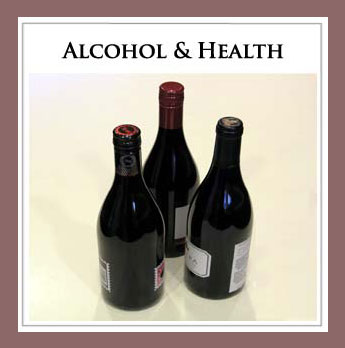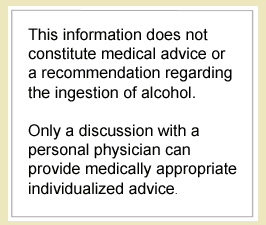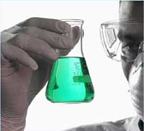Alcohol and Health

Alcohol and Health
E.Roehm, M.D.
Introduction
Moderate levels of alcohol intake have been associated with a reduction in heart attacks and a decrease in total death rate in multiple studies.1-3 Higher levels of alcohol intake, on the other hand, have been found to increase cardiac and overall mortality.1,4 Since there are no randomized trials of alcohol intake for cardiac and mortality endpoints, these findings are an association rather than cause and effect.

Moderate levels of alcohol intake
What constitutes a moderate level of alcohol ingestion in this discussion?
For women less than or equal to 1 drink daily is moderate ingestion. For men less than or equal to 2 drinks daily is moderate ingestion. A drink in scientific studies often represents 5 ounces of wine, a 12 ounce can or bottle of beer or 1.5 ounces of 80 proof distilled spirits, which all have a similar amount of alcohol present.
HAZARDS OF ALCOHOL
Before discussing the mortality data and findings favorable to alcohol with moderate alcohol ingestion, it is important to highlight some of the many negative health aspects of alcohol. There are numerous medical conditions for which complete abstinence from alcohol is advisable- liver disease, GI bleeding, and history of alcoholism to name a few. The issue of alcohol intake should always be discussed with one’s personal physician in order to determine what is appropriate in regards to alcohol ingestion.
For younger individuals, risk exists with alcohol intake and there are no significant potential health benefits. The diseases for which moderate alcohol intake is potentially beneficial are distinctly uncommon until middle age. Individuals even in their 30s have very little to gain from any possible benefit of alcohol, and have full exposure to the potential negative effects of alcohol.
Alcohol ingestion in younger individuals up into their 30s tends to be episodic and often in a binge related fashion5 which is always a negative factor for health. The potential for accidental injury with episodic drinking is significant.
There is an increased risk of breast cancer with alcohol even at moderate levels of ingestion.6-8 For cancers other than breast cancer, there is an increase in the total number of cancer cases for higher levels of alcohol ingestion. (see Alcohol and Women- Special Considerations for details)
High levels of alcohol intake increase total death rate1 and the incidence of multiple diseases including GI bleeding, cirrhosis, pancreatitis, and overall cardiac mortality9.
In regards to the heart, heart arrhythmias can be provoked, particularly during or following heavy drinking. This includes atrial fibrillation, supraventricular tachycardia, and ventricular arrhythmias.10-14 Moderate levels of alcohol ingestion may be a precipitant in susceptible individuals with intermittent atrial fibrillation. 10
Furthermore, very high intakes of alcohol can cause dilation and severe weakness of the heart muscle called alcoholic cardiomyopathy.15 For individuals with this condition, only a complete and continued cessation of alcohol will potentially allow the heart to return to normal size and function.
Alcohol intake increases blood pressure in men and women. For alcohol intake above 2 drinks daily, blood pressure rises as alcohol intake increases.16
POSSIBLE BENEFITS OF ALCOHOL
Reduction in Death Rate
Multiple observational studies have shown an association of moderate alcohol intake with an improvement in overall survival and a decrease in heart attack rate and cardiovascular mortality1-3. The effects on total mortality can be viewed in a sense as a summation of the major positive and negative effects of alcohol ingestion on health.
There is a reduction in the overall death rate for moderate alcohol ingestion.1 In this discussion, one drink is defined as 14g of alcohol per drink.
Since these studies are not randomized trials, the alcohol can not be said to be the cause of the reduction in death rate. However, even when there is adjustment for other contributing factors, the benefit persists.1
MEN
Men & Alcohol Ingestion- Effect on Total Mortality1 in middle aged and older men
| Alcohol Intake (daily average) | Change in death rate |
|---|---|
| ~ 1/4- 2 drinks/day | ~ 10-15% reduction in mortality |
| ~ 3 drinks/day | no effect |
| 3 or more drinks/day | increase in mortality |
(A drink in this chart is defined as 14g of alcohol/drink)
For men, there is an approximate 10-15% reduction in overall mortality when alcohol is ingested at less than or equal to 2 drinks/per day.1 Alcohol intake has a neutral effect on mortality at an approximate average of 3 drinks daily (21 drinks/week, 42g of alcohol daily) in men. As alcohol intake further increases, the total death rate progressively worsens.
WOMEN
Women & Alcohol Ingestion- Effect on Total Mortality1 in middle aged and older women
| Alcohol Intake (daily average) | Change in death rate |
|---|---|
| ~ 1/4-1 drink/day (1-7 drinks/week) | ~ 10-15% reduction in mortality |
| ~ 1 3/4 drinks/day (12 drinks/week) | no effect |
| 2 drinks/day (14 drinks/week) | ~ 3% increase in mortality |
| 3 drinks/day (21 drinks/week) | ~ 20% increase in mortality |
| 3 or more drinks/day (>21 drinks/week) | further significant increases |
(A drink in this chart is defined as 14g of alcohol/drink)
For women there is an approximate 10-15% reduction in overall mortality for alcohol ingestion at less than or equal to one drink a day.1
As alcohol intake increases the benefit disappears and is replaced by a worsening of the death rate. For women, even an average of 2 drinks per day (14 drinks/week, 28g of alcohol/ day) results in an increase in total mortality. 1
Heart Attack and Overall Cardiovascular Mortality
In men and women, alcohol ingestion at moderate levels of intake (≤ 1 drink a day in women and ≤2 drinks a day in men) is associated with a lower rate of heart attacks and cardiovascular mortality.2,3 Though a lower frequency of heart attacks is present over a wide range of alcohol intakes, stroke rates and total mortality increase as alcohol intake progresses above moderate levels.1,3 There are features of alcohol and the reduction in heart attacks and cardiovascular mortality that are suggestive of a cause and effect relationship. 3
Possible mechanisms of benefit
Alcohol intake increases levels of good cholesterol called high density lipoproteins (HDL). Both HDL1 and HDL2 subfractions increase with alcohol intake.17 Alcohol intake also decreases fibrinogen levels18 which reduces excessive blood clotting and may be beneficial in reducing heart attacks.
In addition, alcohol ingestion improves insulin sensitivity.19 Observational studies have consistently shown an association of moderate alcohol intake with a lower frequency of diabetes.20-21
Summary
In summary, moderate level alcohol ingestion ( ≤1 drink daily in women and ≤ 2 drinks per day in men) correlates with a lower overall mortality and a decrease in the risk of heart attack.1,3 The groups that show the associated benefit are individuals with significant cardiac risk factors and in age groups in which heart attacks occur more commonly, i.e., middle aged and older men and post menopausal women. As levels of intake exceed a moderate level of alcohol ingestion, the associated net benefit resolves and then becomes strongly negative in regards to overall health and mortality.1
What about red wine?
The vast majority of observational studies do not show a difference in the occurrence of benefits and risks between different forms of alcoholic beverage- wine, beer, and hard liquor in equivalent quantities of alcohol. A study in Europe where wine did show an advantage over other alcoholic beverages22 may possibly have been the result of chance or that the wine group may have been associated with other beneficial factors that were not identified.
There are substances found in red wine called bioflavonoids, including resveratrol, that have some favorable properties when tested in isolation. However, only 2-17% of the major bioflavonoids in wine are absorbed when ingested, and the body quickly metabolizes them.23 The majority of the bioflavonoids that enter the body are converted to conjugate forms which have historically been thought to be inactive. This has not been well studied though and it is of note that there are some conjugates of other substances that are more active than the parent compound. 24
The nonalcoholic portion of wine has been shown to be beneficial in some animal studies in inhibiting fat deposition25, but not in others26. There have even been differences in evidence of benefit in other laboratory models between red wines coming from different countries27, so the issue is complex and not entirely straight forward.
And, if there are aspects of wine, such as the tannins in red wine or the tradition of drinking wine with a meal that leads to a more modest intake of alcohol rather than a heavy intake, that may be of potential benefit. In summary, the majority of the observational studies show no difference, though there are some intriguing differences present.
References:
1. Di Castelnuovo A, Costanzo S, Bagnardi V, Donati MB, Iacoviello L, de Gaetano G. Alcohol dosing and total mortality in men and women: an updated meta-analysis of 34 prospective studies. Arch Intern Med. 2006;166:2437-45.
2. Mukamal KJ, Chen CM, Rao SR, Breslow RA. Alcohol consumption and cardiovascular mortality among U.S. adults, 1987 to 2002. J Am Coll Cardiol. 2010;55:1328-35.
3. Ronksley PE, Brien SE, Turner BJ, Mukamal KJ, Ghali WA. Association of alcohol consumption with selected cardiovascular disease outcomes: a systematic review and meta-analysis. BMJ. 2011,342:d671. doi: 10.1136/bmj.d671.
4. Ikehara S, Iso H, Toyoshima H, et al.; Japan Collaborative Cohort Study Group. Alcohol consumption and mortality from stroke and coronary heart disease among Japanese men and women: the Japan collaborative cohort study. Stroke. 2008;39:2936-42.
5. Mukamal KJ. A 42-year-old man considering whether to drink alcohol for his health. JAMA. 2010 May 26;303:2065-73.
6. Smith-Warner SA, Spiegelman D, Yaun SS, et al. Alcohol and breast cancer in women: a pooled analysis of cohort studies. JAMA. 1998;279:535-40.
7. Zhang SM, Lee IM, Manson JE, et al. Alcohol consumption and breast cancer risk in the Women’s Health Study. Am J Epidemiol. 2007;165:667-76.
8. Allen NE, Beral V, Casabonne D, Kan SW, Reeves GK, Brown A, Green J; Million Women Study Collaborators. Moderate alcohol intake and cancer incidence in women. J Natl Cancer Inst. 2009;101:296-305.
9. Wang L, Lee IM, Manson JE, Buring JE, Sesso HD. Alcohol consumption, weight gain, and risk of becoming overweight in middle-aged and older women. Arch Intern Med. 2010;170:453-61.
10. Kodama S, Saito K, Tanaka S, et al. Alcohol consumption and risk of atrial fibrillation: a meta-analysis. J Am Coll Cardiol. 2011;57:427-36.
11. Conen D, Tedrow UB, Cook NR, et al. Alcohol consumption and risk of incident atrial fibrillation in women. JAMA. 2008;300:2489-96.
12. Smile DH. Acute alcohol withdrawal complicated by supraventricular tachycardia: treatment with intravenous propranolol. Ann Emerg Med. 1984;13:53-5.
13. Greenspon AJ, Stang JM, Lewis RP, Schaal SF. Provocation of ventricular tachycardia after consumption of alcohol . N Eng J Med. 1979; 301:1049–50.
14. Singer K, Lundberg WB. Ventricular arrhythmias associated with the ingestion of alcohol. Ann Intern Med. 1972;77:247-8.
15. Shanoff HM. Alcoholic cardiomyopathy: an introductory review. Can Med Assoc J. 1972;106:55-62.
16. Keil U, Liese A, Filipiak B, et al. Alcohol, blood pressure and hypertension. Novartis Found Symp. 1998;216:125-51
17. Gaziano JM, Buring JE, Breslow JL, et al. Moderate alcohol intake, increased levels of high-density lipoprotein and its subfractions, and decreased risk of myocardial infarction. N Engl J Med. 1993;329:1829-34.
18. Brien SE, Ronksley PE, Turner BJ, Mukamal KJ, Ghali WA. Effect of alcohol consumption on biological markers associated with risk of coronary heart disease: systematic review and meta-analysis of interventional studies. BMJ. 2011;342:d636. doi: 10.1136/bmj.d636.
19. Davies MJ, Baer DJ, Judd JT, Brown ED, Campbell WS, Taylor PR. Effects of moderate alcohol intake on fasting insulin and glucose concentrations and insulin sensitivity in postmenopausal women: a randomized controlled trial. JAMA. 2002;287:2559-62.
20. Baliunas DO, Taylor BJ, Irving H, et al. Alcohol as a risk factor for type 2 diabetes: A systematic review and meta-analysis. Diabetes Care. 2009;32:2123-32.
21. Joosten MM, Grobbee DE, van der A DL, et al. Combined effect of alcohol consumption and lifestyle behaviors on risk of type 2 diabetes. Am J Clin Nutr. 2010;91:1777-83.
22. Grønbaek M, Deis A, Sørensen TI, et al. Mortality associated with moderate intakes of wine, beer, or spirits. BMJ. 1995;310:1165-9.
23. Goldberg DM, Yan J, Soleas GJ. Absorption of three wine-related polyphenols in three different matrices by healthy subjects. Clin Biochem. 2003;36:79-87.
24. Hu M. Commentary: bioavailability of flavonoids and polyphenols: call to arms. Mol Pharm. 2007;4:803-6.
25. Waddington E, Puddey IB, Croft KD. Red wine polyphenolic compounds inhibit atherosclerosis in apolipoprotein E-deficient mice independently of effects on lipid peroxidation. Am J Clin Nutr. 2004;79:54-61.
26. Bentzon JF, Skovenborg E, Hansen C, et al. Red wine does not reduce mature atherosclerosis in apolipoprotein E-deficient mice. Circulation. 2001;103:1681-7.
27. Wallerath T, Poleo D, Li H, Förstermann U. Red wine increases the expression of human endothelial nitric oxide synthase: a mechanism that may contribute to its beneficial cardiovascular effects. J Am Coll Cardiol. 2003;41:471-8.


